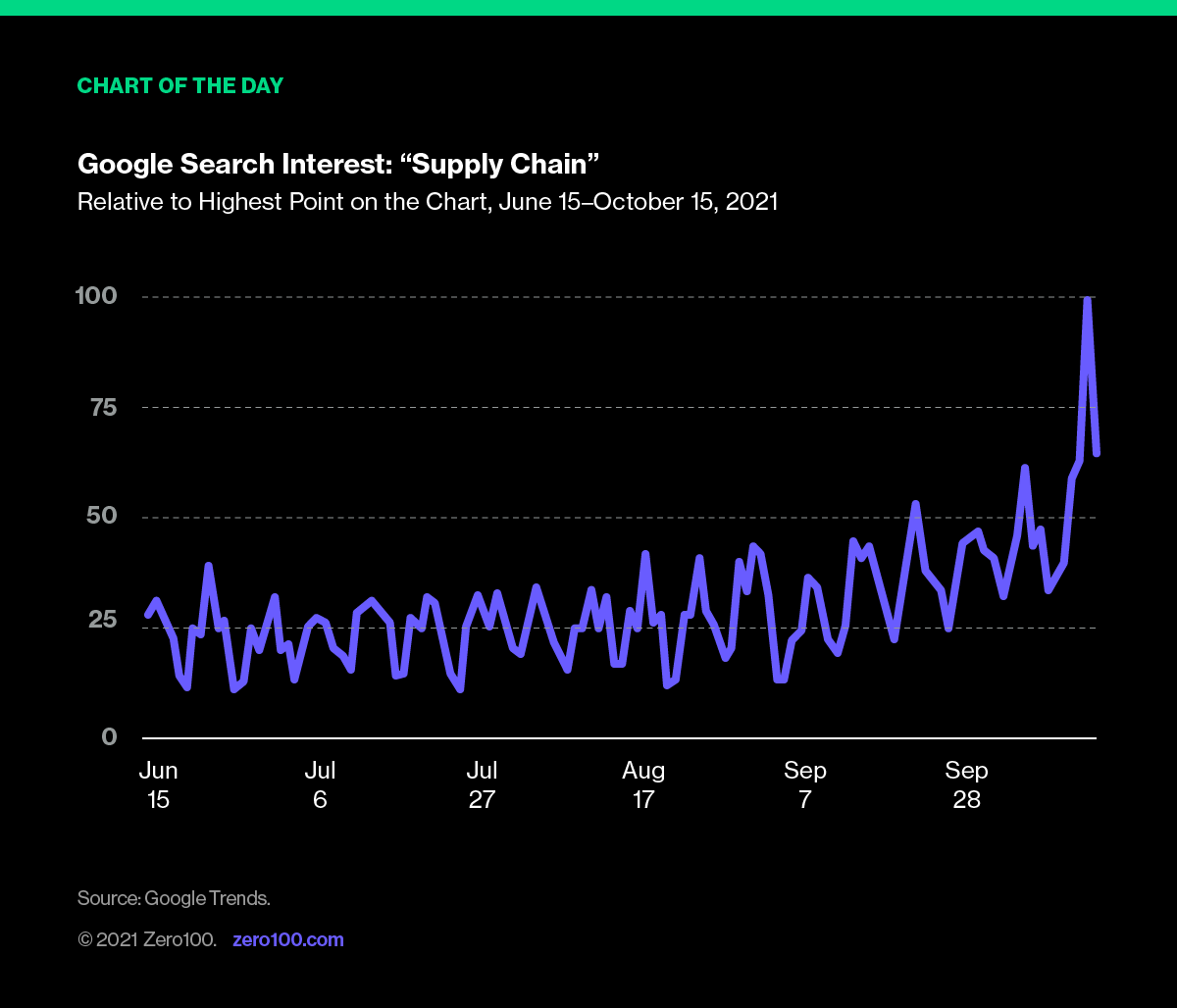We're Trending!!!
According to Google Trends, user interest in “supply chain” reached 2-3x its normal level on the search platform this week—propelled by a media cycle fixated on empty shelves, inflationary risks, and a rapidly approaching peak retail season.

As one explores the undercurrents of this trending topic, it becomes clear that there are numerous attempts to break down a thorny, nuanced topic into its simplest, least complicated form.
Good examples of this includes Jordan Weissmann's “The Absolute Simplest Explanation for America's Supply Chain Woes.” According to the latest Bureau of Economic Analysis (BEA) stats on consumer spending: “By August, inflation-adjusted spending on goods was up +14.5% compared with pre-pandemic.” People are buying a lot more crap. Got it. Good to know my personal levels conspicuous consumption during the pandemic were mirrored by society at large.
Another prime example comes from Neil Irwin in The New York Times: “After the global financial crisis of 2008-9, the great challenge for the recovery was a shortfall of demand. The post-reopening stage of this recovery is the opposite. Now there is plenty of demand . . . but companies report struggles to find enough works and raw materials to meet that demand.” 2008 = Demand crisis. 2021 = Supply crisis. Got it. I vaguely remember my exercise workbook from John Taylor's Principles of Economics.
While I remain a strong proponent of any attempt to demystify complex systems—gross simplification can lead as quickly to broader awareness as it can pave the way to inertia, complacency, and convenient scapegoats. For further proof, look up #emptyshelvesjoe (also trending)...
Chicken or the Egg?
On the flip-side, another undercurrent of this conversation attempts to identify the collateral damage from the fallout of an extended supply chain crunch. If we ignore energy inflation, food insecure households, and a Bob Cratchit-themed Christmas—who is the poor slob on the receiving end of this insult-to-injury finale to 2021? Turns out, it's. . . wait for it . . . the advertising-industrial complex.
No joke—after one of the sharpest contractions in media budgets and greatest channel reallocations in media spend on record, global ad spend was set to rise by +12.6% year-over-year . . . until it wasn't.
This is one of the narratives from this past week that I needed to read over and over again, as comprehension continues to elude my tiny, overtaxed brain. To recap:
- Pent-up demand for consumer goods is at an all-time high, driving a +17.4% surge in U.S. imports, as compared to September 2019.
- After a -5.8% contraction in global advertising, COVID-19 accelerated an ongoing shift to digital marketing—the most agile, responsive, and cost-effective form of advertising in the marketer's toolbox.
- And apparently, brands were planning blow-out holiday campaigns that we now need to cancel or curtail, which in turn, jeopardize the commissions of the last advertising agencies left standing on Madison Avenue.
Stupid question: were forward-looking, data-driven CMOs at consumer brands planning on spending anything in this environment? Do they need to? And if so, why hasn't their CEO robbed Peter (Marketing) to pay Paul (Operations) until balance to the system is restored?
Find Balance in the Force
Between simplification and abstraction lie what I think are some crucial takeaways for supply chain leaders. The lack of synchronicity between manufacturing and marketing has been front-and-center throughout the pandemic. Toilet paper rolls, Peloton bikes, and PlayStation 5's offer a myriad of explanations about supply-demand imbalances that lead to inequitable outcomes.
Where we need to go next is a careful, thoughtful examination of what other processes along an extended supply chain are related in order to pressure test the system and insulate it from future shocks to the system.
Which leads up to the “glass half-full” stories of the week. Do efforts to upcycle food waste back into animal feed give us a similar window onto the source-sustain imbalance? Can 3D printing efforts finally live up to the hype of shorter supply chains at the core of the deliver-channel imbalance? We'll find out. We have to...
Critical Reading
THE NEW YORK TIMES
The Great Supply Chain Disruption
Commentary: Excellent extension of Peter Goodman's man-on-the-ground reporting from the Port of Savannah. Well worth a listen.
#podcast
THE HILL
White House: Walmart, FedEx, UPS to go 24/7 to address supply bottlenecks
Commentary: As the political fallout from the supply chain crunch expands, we see more stop-gap solutions and fewer follow-up from the 100-Day Report released by the administration last June.
#logistics #policy
ARS TECHNICA
IBM says AI can help track carbon pollution across vast supply chains
Commentary: Exciting profile of how Big Data (Weather Company) and Artificial Intelligence (Watson) can be leveraged to crack “Scope 3” emissions.
#sustainability #AI
